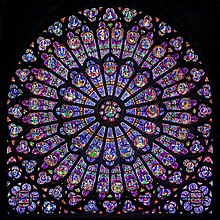tracery
Jump to navigation
Jump to search
English
[edit]
Etymology
[edit]Pronunciation
[edit]Noun
[edit]tracery (plural traceries)
- (architecture) Bars or ribs, usually of stone or wood, or other material, that subdivide an opening or stand in relief against a door or wall as an ornamental feature.
- 1921, Elizabeth Boyle O'Reilly, How France Built Her Cathedrals[1], Harper & Brothers, page 140:
- Because of the flamelike undulations of its window tracery, the Norman archæologist, M. de Caumont, who had brought into use the name Romanesque, invented the equally useful term Flamboyant.
- (by extension) A delicate interlacing of lines reminiscent of the architectural ornament.
- 1874, Robert Louis Stevenson, “Ordered South”, in Virginibus Puerisque and Other Papers, London: C[harles] Kegan Paul & Co., […], published 1881, →OCLC:
- He is homesick for the hale rough weather; for the tracery of the frost upon his window-panes at morning, the reluctant descent of the first flakes, and the white roofs relieved against the sombre sky.
Derived terms
[edit]Translations
[edit]bars or ribs as an ornamental feature